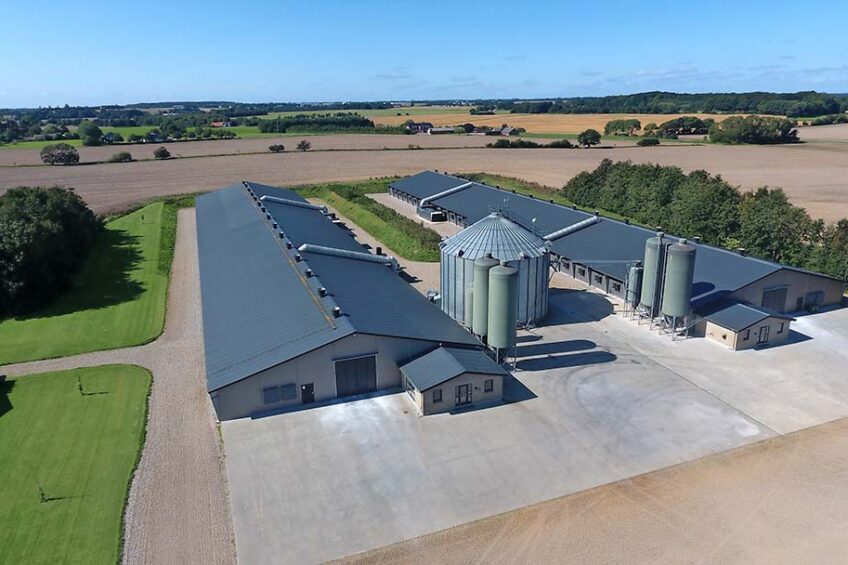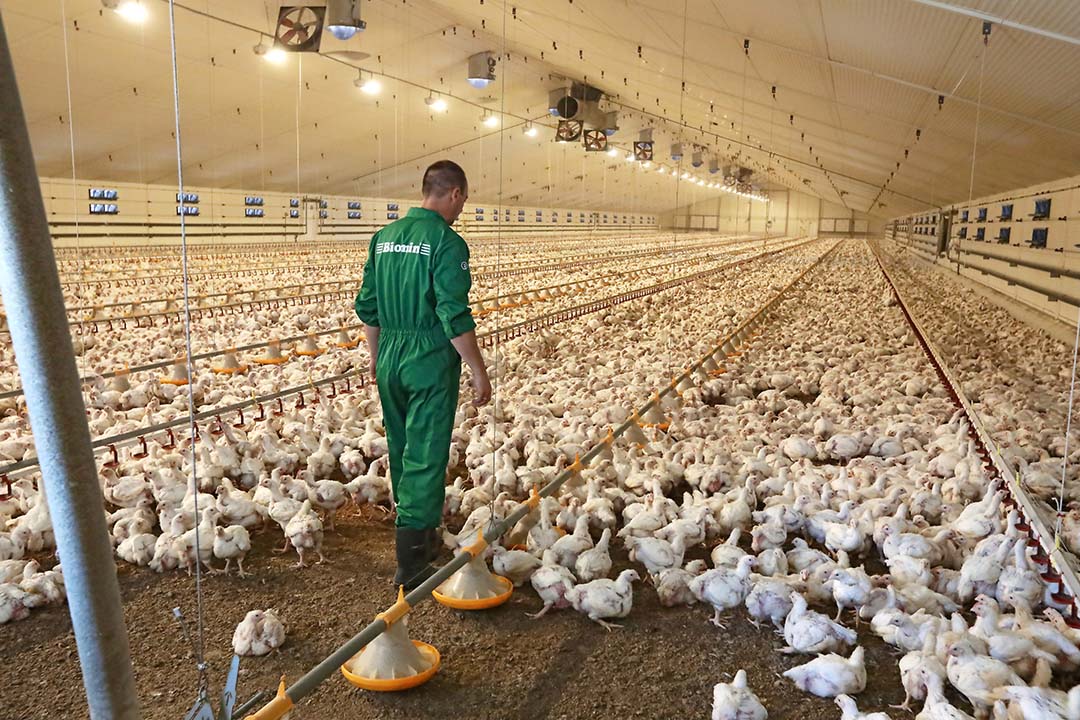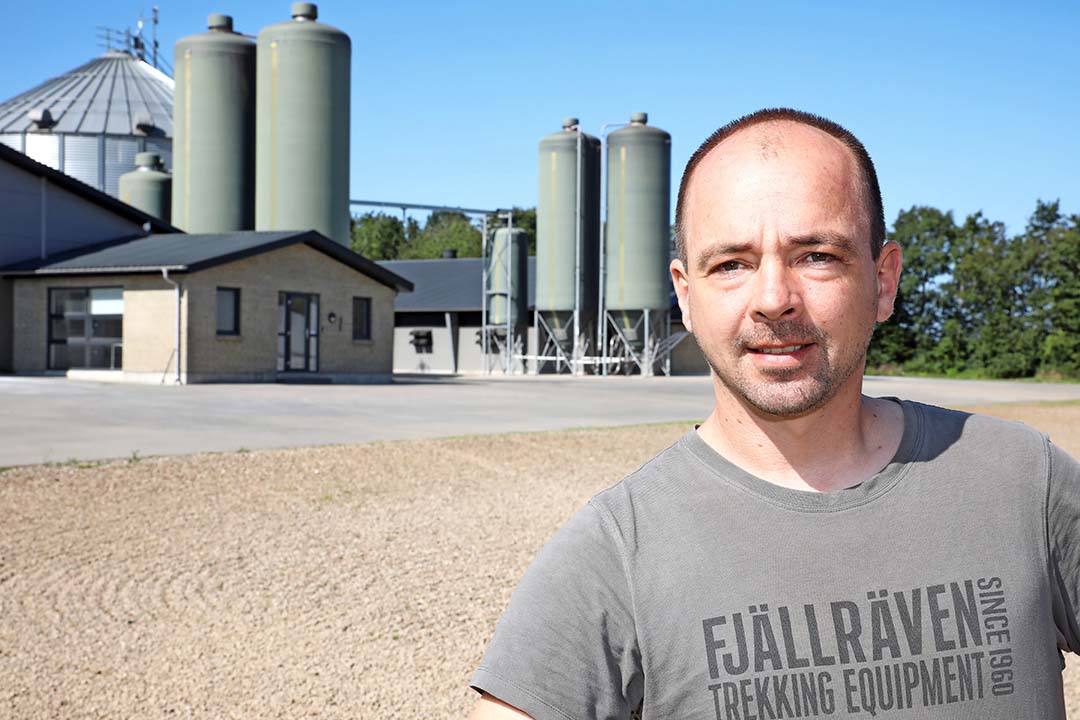No demand for slower-growing broilers in Denmark

As in every developed market, slower-growing broilers are on people’s minds. But Danish broiler farmer Rune Thomsen sees no immediate need to switch from fast to slower growth. “There is no current demand to cater for.”
The grow-out houses on Danish broiler farms have the same setup and design as almost everywhere else. That is immediately clear when entering the broiler houses of the Williamsborg farm in Hedensted, Denmark. Feed lines from Landmeco, combined top and longitudinal ventilation, inlet valves from Skov, 6 water lines and thick bedding. The same setup and systems can be seen in Germany, the Netherlands or the UK.
However, an air washer is missing in the Hedensted houses that are less than 8 years old. “They are not mandatory in our sector,” says farm manager Rune Thomsen. “You hardly see them in our country. But that does not mean the environment is taken for granted.” What are the serious points of discussion in Danish poultry farming? “Sales, prices, feed quality and permits,” the Dane replies.
Permits
The estate bought a very outdated pig farm in 2015 with 60 hectares of land. “We converted it to poultry which is a much better fit with our labour supply. Apart from planned peaks, such as set-up, catching and cleaning, the chicks require 3 hours labour a day.” Thomsen notes that the permits were already slow to arrive at the time when he bought the farm. The pig sheds have been demolished, 2 sheds with 55,000 broiler places each were built in 2016 and 2017, in addition to the 35,000 places the company has elsewhere. “We are a typical Danish poultry farm, with houses of 3,000 sqm.”
Despite good returns, the farm is not on course for further expansion with new construction. “A permit for a larger operation would require 5-10 years of negotiation and procedures with local government because of our short distance of about 2 km from the town. People are fearful about the harmful effects of ammonia,” says Thomsen. “We are keeping the option of expanding open by buying an existing farm. They are relatively cheap given the high construction costs now. And we estimate that those construction costs will remain high for the next few years.”
No demand for slow-growing birds
The company raises fast-growing Ross 308 chicks. “Slow growth is not in demand in Denmark. That said, mirroring the Netherlands, where supermarkets have opted for slow growth, slower growing was once the vision of a slaughterhouse here, too,” says Thomsen. Slower-growing only refers to the growth rate of the birds. The stocking density at the end of the cycle does not differ from fast-growing: approximately 38 kg/m2. There is also no covered outdoor area requirement for slow-growing animals. “The Dutch Beter Leven label sets strict standards but the demand comes from the market and the market does compensate them for it! That is not the case in Denmark.”

In Denmark, 2 processors, HKScan (Rose Poultry) and Sandi Standard Danpo, both handle about a third of the total slaughter capacity. In addition, there are about 6 small processors. “Danpo wanted to completely switch to a concept with hatching on farm and slow-growing chicks in 5 years’ time,” explains Thomsen. “Due to the Ukraine crisis, feed became very expensive and the price of poultry meat in the shops rose sharply. Consumers then massively stopped buying the more expensive meat of slow-growing chickens. Danpo has now retraced its steps and since September 2023 has switched back to chicks from hatcheries and fast-growing chicks. It cost Danpo a lot of money.”
Thomsen supplies to HKScan that does buy slow-growing chicks at a premium, but only when there is a demand for them. But he is not considering switching to slow-growing chicks. “It is not the government but the market that determines what we have to deliver. Slow growth is too dependent on the emotions of unpredictable consumers. I want to act based only on data. Yes, you can push the Ross 308 over the limit, have it grow so fast that its health deteriorates. But feed consumption is lower than with slower-growing varieties and feed costs are everything in this sector. In addition, CO2 emissions are lowest with regular chicks, which is an increasingly important purchasing argument for consumers.”
Openness trumps
The openness in the Danish broiler sector, which has just under 200 companies, is striking. The most important technical results, such as feed consumption, mortality rate and variation in delivery weight, are aggregated per feed supplier and feed production location, and are available online.
“In recent flocks we have had trouble getting to 2,200g within 34 days. Each time we missed 50g to 100g. In the database we can see that this is the case with all feed suppliers. This may have to do with the purchasing of the commodities.” Even though the problem is sector-wide, Thomsen has persevered. The flock in the smallest of his 3 houses received feed from another supplier than the one he has been doing business with for 8 years.

The switch to another supplier makes it clear that the feed industry does not play an important role in the Danish broiler sector. It also shows that the manager likes to test things. “That’s what I enjoy about in my work. With broilers you can easily experiment with type of feed, light schedule, temperature and ventilation, and so on. After 6 weeks you know whether something works or not, and you can implement it in all the houses if the results are better. And if things deteriorate, you will not lose more than a few thousand euros.”
The estate grows grain on almost 1,000 hectares. Yet not an ounce of their own grain is fed to the broilers anymore. “The slaughterhouse rewards uniformity. The chicks select in the feed with our own grain which reduces uniformity. The sale of our grain and the purchase of feed pays off.”
The compound feed companies work partly with a form of fixed prices. “If, for example, the soy price seems interesting, we secure that commodity via the feed supplier.” This could also be done via a futures market contract on the Chicago Exchange, he acknowledges, “but the system has developed this way and it works to our complete satisfaction.”












